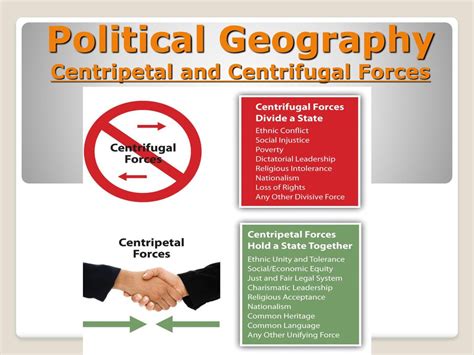Introduction

Centrifugal forces, the forces that pull people away from a particular geographic location, play a significant role in shaping human settlement patterns and migration flows. These forces can be both internal (within a society) and external (external to a society). In this article, we will explore the various centrifugal forces that influence human geography and their multifaceted impacts on human societies.
Internal Centrifugal Forces
Economic Disparities
One of the most significant internal centrifugal forces is economic disparity. When regions within a country experience significant economic disparities, people tend to migrate away from less-developed regions in search of better economic opportunities. This trend is evident in the mass migration from rural areas to urban centers in developing countries.
Political and Social Conflicts
Political and social conflicts within a country can also trigger centrifugal forces. When people feel that their basic rights and freedoms are threatened, they may choose to flee to safer regions. For example, the Syrian civil war has resulted in the displacement of millions of people, who have sought refuge in neighboring countries and beyond.
Environmental Factors
Environmental degradation, such as desertification, deforestation, and natural disasters, can also lead to centrifugal forces. When people’s livelihoods are threatened by environmental issues, they may migrate to more favorable locations. For example, the drought in the Horn of Africa has forced millions of people to leave their homes in search of food and water.
External Centrifugal Forces
Globalization
Globalization, the interconnectedness of the world through trade, technology, and communication, has created both centrifugal and centripetal forces. On the one hand, it has facilitated easier migration and increased opportunities for people to work and live abroad. On the other hand, it has also led to increased competition and the outsourcing of jobs, which has pushed people to seek opportunities in other countries.
International Conflict
International conflict can also create centrifugal forces. When countries engage in war or political disputes, people may be forced to flee their homes to avoid persecution or violence. According to UNHCR, there were over 26 million refugees worldwide in 2022.
Climate Change
Climate change is becoming a major external centrifugal force. Rising sea levels, extreme weather events, and changing agricultural patterns are forcing people to relocate from vulnerable coastal areas and low-lying countries to higher and more stable regions. The World Bank estimates that climate change could displace up to 216 million people by 2050.
Impacts of Centrifugal Forces
Urbanization
Centrifugal forces contribute significantly to urbanization. As people migrate from rural areas to urban centers in search of economic opportunities or to escape conflicts, urban populations swell. This trend has led to the rapid growth of megacities and urban sprawl.
Economic Development
Centrifugal forces can both hinder and promote economic development. The loss of skilled labor to emigration can slow down economic growth in sending countries. However, immigration can also bring new skills and perspectives to receiving countries, which can boost economic productivity.
Social and Cultural Change
Centrifugal forces often lead to social and cultural change. The migration of people from different backgrounds and cultures can lead to the diversification and transformation of societies. It can also create challenges related to integration and intercultural understanding.
Responses to Centrifugal Forces
Government Policies
Governments can implement various policies to address the effects of centrifugal forces. These policies may include:
- Investing in economic development in less-developed regions to reduce economic disparities
- Promoting political stability and social cohesion to prevent conflicts that trigger displacement
- Addressing environmental issues to minimize the displacement caused by environmental degradation
International Cooperation
International cooperation is crucial in addressing the challenges posed by centrifugal forces. This cooperation can involve:
- Providing humanitarian assistance to refugees and displaced persons
- Establishing global frameworks for managing climate change and its impacts
- Promoting trade and economic opportunities to facilitate orderly migration
Community-Based Initiatives
Community-based initiatives can also play a vital role in responding to centrifugal forces. These initiatives can include:
- Creating support networks for migrants and refugees
- Promoting intercultural understanding and integration
- Developing local economic opportunities to reduce the need for migration
Conclusion
Centrifugal forces are powerful shapers of human geography. They influence migration flows, urbanization patterns, economic development, and social and cultural change. Understanding these forces and their impacts is essential for developing comprehensive policies and strategies to address the challenges and opportunities they present. By embracing a holistic approach that combines government policies, international cooperation, and community-based initiatives, we can mitigate the negative effects of centrifugal forces and harness their potential for positive change.
Tables
Table 1: Key Figures on Internal Centrifugal Forces
| Factor | Number |
|---|---|
| Economic migrants | 153 million |
| Refugees and IDPs | 96.2 million |
| Environmentally displaced persons | 2.6 million |
Table 2: Key Figures on External Centrifugal Forces
| Factor | Number |
|---|---|
| International migrants | 281 million |
| Refugees | 26.4 million |
| Climate change displaced persons | 216 million (projected by 2050) |
Table 3: Impacts of Centrifugal Forces
| Impact | Economic | Social | Environmental |
|---|---|---|---|
| Urbanization | Urban growth, infrastructure strain | Social inequality, cultural change | Urban heat island effect |
| Economic development | Skilled labor shortage, brain drain | Remittances, new skills | Resource depletion, environmental degradation |
| Social and cultural change | Integration challenges, social cohesion | Cultural diversity, intercultural understanding | Climate migration, environmental justice |
Table 4: Responses to Centrifugal Forces
| Level | Policy |
|---|---|
| Government | Invest in development, promote stability, address environmental issues |
| International | Humanitarian assistance, global climate action, migration management |
| Community | Support networks, integration initiatives, local economic development |
